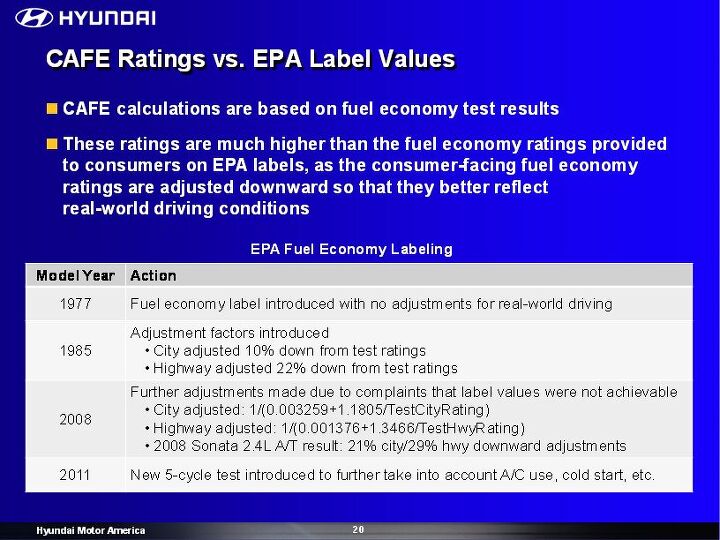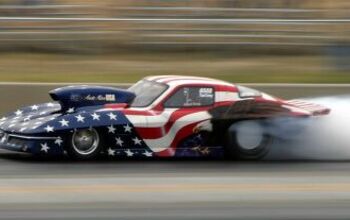Who's Afraid Of CAFE? Not Hyundai
Remember how the government bailout team forgot to make sure its “Irrevocable Ecological Commitment” from Fiat was measured in “adjusted” Miles Per Gallon, using the EPA test cycle that provides your window sticker number? Well, the same “unadjusted” MPG number Sergio Marchionne used to his advantage is used to calculate the CAFE ratings that have the industry in such an tizzy. Well, the official lobbying parts of the industry, anyway [see also, here]. Hyundai has been saying for some time that it is targeting a 50 MPG fleet average by 2025, although CEO John Krafcik said as recently as August that he didn’t know how the automaker would reach that goal. Now, however, it looks like he’s found a way to bring 50 MPG within reach: use CAFE’s “unadjusted” standard. Just like Sergio. Follow along as Hyundai shows that 50 MPG isn’t as far off as many seem to believe.
Here you can see at the serious discrepancy between the EPA’s “adjusted” or “window sticker” fuel economy numbers and CAFE’s “unadjusted” numbers as demonstrated by the 2011 Sonata. In this example, a currently-available, American-built midsized sedan comes within 3.4 MPG of the proposed 2016 CAFE standard for passenger cars (37.8 MPG combined)… despite having a 26 MPG combined EPA sticker.
Using the discrepancy demonstrated in the previous slide, Hyundai points out that a 50 MPG combined unadjusted (“50 MPG CAFE”) vehicle will actually get only 37 MPG on its combined “window sticker” EPA number. Which starts to sound quite attainable when you consider the next slide:
For CAFE purposes, Hyundai’s “midsized” (using EPA interior volume ratings, rather than CAFE “footprint” just to confuse things) non-hybrid Elantra gets 44.4 MPG combined. That means 50 MPG is well within a generation of development, according to the Korean automaker. Though ambitious, an 11 percent reduction in fuel consumption in a four-year development cycle is no moon-shot… and it would put the Elantra at 50 MPG in time for the 37.8 MPG passenger car standard proposed for 2016.
Of course, Hyundai doesn’t have the future fuel economy regulations in a chokehold just yet. There are, after all, the Equus, Genesis, Azera, Sonata and “light trucks” to worry about. Besides, it looks like the EPA (or, at least its its pals at CARB) have 62 MPG in mind for 2025, a target which ups the ante even farther than the 50 MPG Hyundai had anticipated.
And, since we’re making sense of this for the benefit of consumers, we have to also point out that automakers are getting better at gaming even the “adjusted” EPA test to deliver a window sticker number that can be nearly impossible to replicate in the real world. If achieving the CAFE standard can be easy, EPA and the manufacturers need to make sure the “adjusted” numbers on window stickers are actually more relevant than “unadjusted” CAFE numbers. Or better yet, stop confusing the consumers, media and policymakers, and measure CAFE with a “real world” number that can be displayed on EPA window stickers with confidence.
More by Edward Niedermeyer
Latest Car Reviews
Read moreLatest Product Reviews
Read moreRecent Comments
- FreedMike Civic for the win based on looks. But continuing with the "but...Mazda" theme, I take a 3 over either of these.
- Buickman HI-LOW?
- Redapple2 175,000 miles? Wow. Another topic, Hot chicks drive Cabos at higher % than most other cars. I always look.
- Mister When the news came out, I started checking Autotrader and cars.com for stickshift Versas. There are already a handful showing at $15.3k. When anybody talks about buying a new Versa, folks always say that you're better off buying a nicer used car for the same money. But these days, $15.3k doesn't buy very many "nicer used cars".
- 28-Cars-Later A little pricy given mileage but probably not a horrible proposition for a Sunday car. The old saying is you're not buying a pre-owned car you're buying the previous owner, and this one has it hooked up to a float charger (the fact he even knows what one is, is a very good sign IMO). Leather and interior look decent, not sure which motor this runs but its probably common (for VAG at least). Body and paint look clean, manual trans, I see the appeal."but I think that's just a wire, not a cracked body panel." Tim, its a float charger. I am doing the exact same thing with the charger hanging via a magnetic hook on the HVAC overhead in my garage.





































Comments
Join the conversation
The unadjusted numbers are simply what is actually measured during the EPA prescribed test cycles. At first, these where the only numbers published and they became the basis for the CAFE rules. But, for a number of reasons, few people achieve numbers similar to the unadjusted numbers, so a method of down rating them such that the window stickers would more closely conform to what a majority of drivers would see was put into place long ago. It has been this way ever since. There is nothing nebulous about how this is done at all. The procedures are well documented and published.
The EPA "highway cycle" actually is run at an average speed of around 48 mph and never exceeds 60 mph. Drive your vehicle that way and you too can get amazing fuel economy.
http://www.dieselnet.com/standards/cycles/hwfet.html
I'm not sure why none of you guys can get EPA numbers. The 2 autos I own both achieve "80/20" (highway/city) mixed equaling the EPA highway numbers.... The hardest # to hit is the city. Highway is super easy long as you don't drive like you are in F1 or nascar. 2005 STi: 2011 numbers (total miles/total galons, not some computer mumbo jumbo): 22.1mpg mixed. Rating is 16/22 2000 plymouth neon: rating 22/28. Mixed: 28.2 (same mix as above). This is my commute which goes 35 miles each way... Why people can't get those numbers? They have lead foot/feet. It surprises me that I still see people blowing by me at 80 in a 50 when gas in Chicago has hit $3.60'ish a gallon for regular.